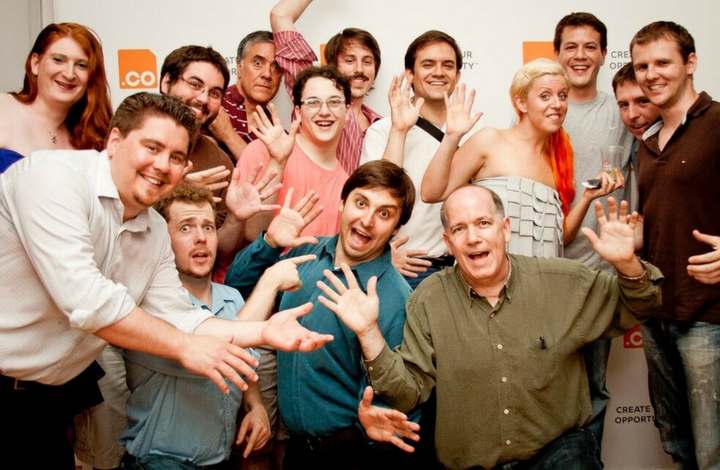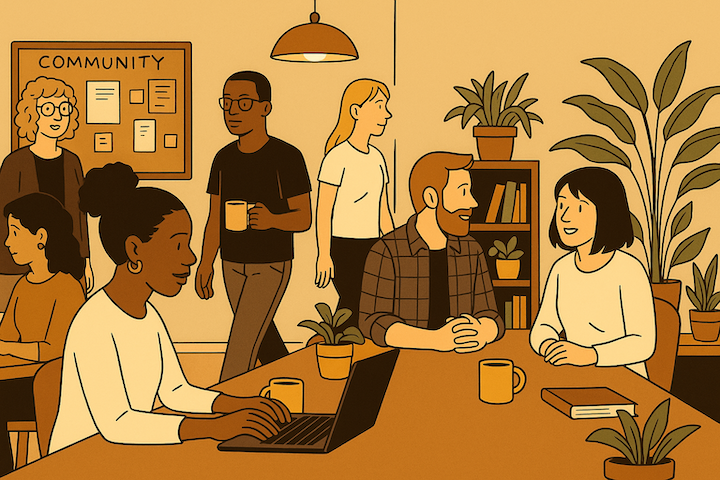A common question among coworking space operators is how to attract new members. Whether it’s a new space just opening its doors, a space that’s been middling at 70 percent capacity for a few years, or a space that’s seeing increased local competition, attracting members is essential to running a sustainable coworking space. The flip side to the question of attracting members—and one that gets far less attention —is how to retain the members you already have.
Tony Bacigalupo has some practical tips on both attracting and retaining members. He’s a treasure chest of information, advice and insights about running a successful coworking space and cultivating community. A pioneer of the coworking movement, Bacigalupo is the founder of New Work Cities, an organization helping people build thriving collaborative communities.
He’s also the author of No More Sink Full of Mugs: Lighten Your Workload, Increase Participation, and Build Better Culture in Your Coworking Space, and creator of The Organizers Club, a membership organization where space managers can access a toolkit of resources, as well as group coaching and online discussions.
I chatted with Bacigalupo about re-engaging existing members, how to create programming aligned with member needs and interests, and common mistakes coworking space operators make when trying to attract and retain members. Here are the highlights of our conversation.
Cat Johnson: Ideally, coworking spaces are full of highly engaged, active members, but this isn’t always the case. What are some things that make people want to engage in their community and space?
Tony Bacigalupo: The real thing we’re asking when we think about what motivates people to engage are, what are their needs, what are their interests? People engage when they have a need that an activity or invitation aligns with. For example, if someone’s working on their taxes and there’s a program to help people answer common questions about taxes, that person is likely to show up to that event because it aligns with a need they have in that moment.
One of the big mistakes a lot of spaces make is that they try to get people to come to programs when, a lot of times, people just don’t have a need that matches that program.
What are some other mistakes coworking space operators may be making that either prohibit, or don’t actively support, engagement among members?
One of the mistakes is trying to get members who don’t want to engage to engage, and trying to force that or impose that. What it comes back to is that there’s only so much you can do to motivate somebody who’s not looking to relate the community in that way.
That comes back to how you start the relationship, which is where most of the foundation gets laid for whether a person is going to be an active participant in the community.
If you’re just recruiting people based on when they need to rent space, then they rent space and that’s your relationship with them. They’re going to be unlikely to participate in things because the relationship is about space and not participation. If you instead recruit based on your programming, and specifically get people to join because they want to participate in a program that is available to members, then the reason the person walks into the space isn’t to rent space, but to participate.
You recommend a community audit to glean information from your members about what’s working and not working. What does that look like in practice?
You need to get a sense of who you’re actually dealing with. It’s so easy to get into abstract—to say, we want more members. But, who are your members? Which ones always show up, which ones never show up, and which ones are in-between?
Once you have them color-coded or grouped up, you can orient your activities around those particular people and their needs. You can look at the people who are very active and say, “These people seem to be very special. Are we doing everything we can to encourage them to take leadership in the community, and feel empowered to really be able to contribute?”
There are people who are eager to become those superstar, champion members who run great programs in the space and do so many valuable things. You need to give them some power, some ability, to do that.
Then, with the people who are somewhat engaged, say, “What do we know about those people and their interests? Can we talk to them, find out more about them, and figure out ways to give them a reason to participate more?”
The people on the disengaged side, you ask, “How do we re-engage these folks?” Reach out to them and figure out what’s going on with them. If you do this exercise with your staff, you might realize there are a few people at the bottom of the list that no one knows anything about. Or you might find that someone’s been a member for a long time and they used to be really involved, but you haven’t heard from them in a while.
This is the perfect opportunity for someone to reach out to them. What you might find is someone who’s on the verge of cancelling, who felt like their needs weren’t getting met—but that absolutely could be met—can tell you what’s going on for them. You can give them a fresh way of re-engaging with the community.
Do you have any tips on getting people to open up about what’s working, and not working, for them?
Ask people a lot about themselves—what’s going on for them, what their needs are. You can be a little vulnerable, a little upfront, and say, “We’re here to be valuable to folks like you. For us to exist, we need to be doing a great job of giving you every reason to want to continue to be a member here. That means helping you be happy, helping you be successful, helping you be excited to be here. What do you wish we would do to make you really excited to be here?”
Once space operators have member feedback, how do you decide which ideas to implement?
Once you have the information, there’s a good chance it becomes readily apparent that there’s a specific action, or a few specific actions, that can be taken that will help you retain your members better and potentially attract new members, as well.
Look for the easy win. Is there a tiny change you can make that can have a disproportionately large impact? Coworking space operators often don’t have unlimited resources, so look for those things that can be maximum impact for minimum effort.
If it turns out that you need to get a bigger space, or there’s another big project, that’s okay too, but it has to go into longer-term planning. What’s the short-term, quick, easy stuff you can just knock off, what’s the medium-term stuff you can work on, and what’s the big picture stuff you really need to take your time with?
How can you take insights shared from existing members to attract potential members?
If you have happier members, then those members are going to talk. A lot of times that makes a huge difference on its own. There are specific things come out of it, maybe a particular program, or adjustments to the space, or even just that you did the exercise.
Transparency has a lot of advantages to it. You can tell potential members that you did an audit of your members and let them know what you found. Then share the steps you’re taking to make the member experience better. Then you can say, “Maybe you’d like to become a member and help us make all this happen.” That can demonstrate that you really care.
Anything you’d to add?
It helps if you create rhythms in your management for your team to spend time together getting familiar with the membership. The member audit is something that, ideally, you do as a collaborative exercise. Fill out the worksheet and put notes in around the members you know or don’t know. Then you can all see who knows which members, and which members no one knows. Doing that exercise helps everybody get on the same page.
Resources:
- Organizers Club
- No More Sink Full of Mugs: Lighten Your Workload, Increase Participation, and Build Better Culture in Your Coworking Space
Note: Tony Bacigalupo is a smart and experienced coworking consultant and industry leader. You’d be wise to take his advice on pretty much anything coworking-related. Some of the above links to Tony’s products and services are affiliate links, which means that, at no cost to you, I get a small commission and you get Tony’s invaluable guidance. Win-win.
Photos courtesy of Tony Bacigalupo.








